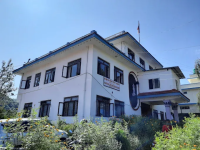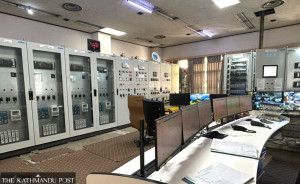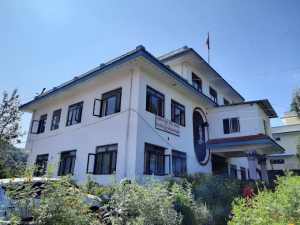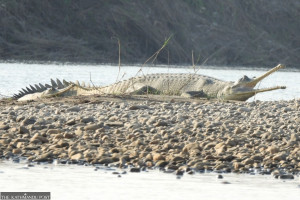Bagmati Province
Rapti embankment in Chitwan hinders animal movement
On Monday, a park rhino was seen struggling to navigate a newly constructed dyke on the Rapti riverbank, leaving conservationists worried.
Ramesh Kumar Paudel
The construction of a dyke wall along the bank of the Rapti River on the Sauraha side has been causing problems in the free movement of wildlife in the area.
Any infrastructures built in the national park areas and forests should be wildlife-friendly. However, this notion was completely ignored while building the embankment on the Rapti river near the eastern sector office of the Chitwan National Park. The area is frequented by the endangered one-horned rhinoceros and gharials, among other animals.
The Rapti river bank is arguably the best destination in the country to enjoy sunset views.
On Monday, a rhino showed up in the area as the sun was descending towards the western horizon. It was an eight-year-old male rhino named Meghauli. The pachyderm apparently was making its way towards the Sauraha area.
Meghauli, which was rescued and raised in human supervision before it was released in the wild, wants to roam around the farmlands in Sauraha. The rhino attempted to climb up the dyke. People visiting the riverside restaurants gathered to see the pachyderm. It was not easy for the rhino to climb around the 10 metres long sloped dyke. Its hooves frequently slipped and it even knelt down at one point. The dyke surface, although rough, posed like a slide for Meghauli who had to struggle to cross it.
“The rhino’s struggle to cross the dyke is heart wrenching for wildlife enthusiasts. On the opposite bank of the river, gharials and magar crocodiles are seen basking in the sun. But they are hardly seen on the dyke side because the construction has left no sandy bank,” said Birendra Mahato, a representative of ward 6 of Ratnanagar Municipality who is active in wildlife conservation campaigns.
Mahato says construction of the dyke in such a sensitive place hugely impacted wildlife movement and their conservation. “It was wrong to construct such infrastructures on the river bank without conducting an Environmental Impact Assessment (EIA). Proper study has not been conducted so far regarding its impacts on the wildlife,” he asserted.
It was the Water Resources Research and Development Centre in Lalitpur that constructed the dyke last year by using ‘fabric-formed concrete mattress’ technology. The fabric-formed concrete mattress was imported from France and used for the first time in the Rapti river to control flooding. A total of Rs 69.8 million was spent on the construction.
According to Jebin Tamrakar, senior divisional engineer at the centre, the fabric-formed concrete mattress was used in the Rapti river area for research purposes to see whether it can be useful in Nepal or not.
Conservationists argue that construction of such embankments in the Sauraha area is unfair to wildlife. “It is not wrong to build an embankment to protect Sauraha from flooding. But the authorities should study its possible impacts on wildlife,” said Surajan Shrestha, chairman of Animal Right Club working in wildlife conservation.
Chitwan National Park, the country’s first protected area, has assuresd to take initiatives if the dyke is found to be disrupting wildlife movement. “We saw the video clip on social media in which the rhino was seen struggling to cross the embankment. We did not know about this issue. The national park is cautious not to create any difficulties for rhinos,” said Ganesh Prasad Tiwari, the information officer at the national park.
He said it is not mandatory, according to the legal provisions of the country, to conduct an Environmental Impact Assessment and Initial Environmental Examinations for the construction of embankments or any other infrastructures which are less than 10 kilometres long.
Chitwan National Park is home to various endangered species of flora and fauna including one-horned rhinoceros, royal bengal tiger, and gharial crocodiles, among others.




 9.12°C Kathmandu
9.12°C Kathmandu1.jpg)











%20(1).jpg&w=300&height=200)

